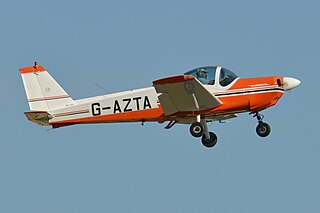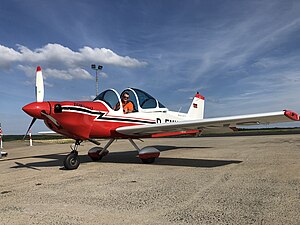
The CASA C-101 Aviojet is a low-wing single engine jet-powered advanced trainer and light attack aircraft designed and manufactured by Spanish aircraft company Construcciones Aeronáuticas SA (CASA).

The Pitts Special is a series of light aerobatic biplanes designed by Curtis Pitts. It has accumulated many competition wins since its first flight in 1944. The Pitts biplanes dominated world aerobatic competition in the 1960s and 1970s and, even today, remain potent competition aircraft in the lower categories.

The Messerschmitt-Bölkow-Blohm Bo 105 is a light, twin-engine, multi-purpose helicopter developed by Bölkow of Ottobrunn, West Germany. It was the first light twin-engine helicopter in the world, and the first rotorcraft that could perform aerobatic maneuvers such as inverted loops. The Bo 105 features a hingeless rotor system, a pioneering innovation in helicopters when it was introduced into service in 1970. Production of the Bo 105 began at the then-recently merged Messerschmitt-Bölkow-Blohm (MBB).

The Taylor Titch is a British fixed-wing homebuilt aircraft, developed in the 1960s by J.F. Taylor. As of 2015, examples are still being built and flown.

The Zlín Z 42 is a single-engine two-seat Czechoslovakian trainer aircraft manufactured by Moravan Otrokovice. A developed version, the Z 142, is the most popular aircraft variant in the manufacturer's aircraft line.

The Malmö Flygindustri MFI-9 Junior was a light aircraft produced in Sweden in the 1960s. The aircraft was also produced under licence in West Germany as the Bölkow Bo 208.

The Taylor J.T.1 Monoplane is a British fixed-wing aircraft design for a homebuilt aircraft, developed in the 1950s by J.F. Taylor.

ENAER T-35 Pillán is a Chilean propeller-driven basic trainer aircraft. The student and the instructor sit in tandem. Production ceased in 1991 after 7 years but restarted briefly in 1998.

The Bölkow Bo 103 was an ultralight experimental helicopter flown in West Germany in 1961. It was designed for reconnaissance and command-control purposes and constructed by Bölkow Entwicklungen KG as part of a research order by the German Federal Ministry of Defense.

The Bölkow Bo 207 was a four-seat light aircraft built in West Germany in the early 1960s, a development of the Klemm Kl 107 built during World War II.

The MBB Bo 209 Monsun is a two-seat light aircraft that was designed by the West German company Bölkow and originally produced by Messerschmitt-Bölkow-Blohm (MBB).

The Klemm Kl 107 was a two-seat light aircraft developed in Germany in 1940. It was a conventional low-wing cantilever monoplane of wooden construction with fixed tailwheel undercarriage. Wartime production totalled only five prototypes and some 20 production machines before the Klemm factory was destroyed by Allied bombing. Following World War II and the lifting of aviation restrictions on Germany, production recommenced in 1955 with a modernised version, the Kl 107B, of which Klemm built a small series before selling all rights to the design to Bölkow. This firm further revised the design and built it as the Kl 107C before using it as the basis for their own Bo 207.

The Mudry CAP 10 is a two-seat training aerobatic aircraft first built in 1970 and still in production in 2007. The plane was developed from the Piel Super Emeraude and was born as the CP100. The name changed to CAP 10, CAP for 'Constructions Aéronautiques Parisiennes'. The CAP 10 was manufactured by Mudry in Bernay, France, bought by CAP Industries which then became Apex Aircraft. Following the bankruptcy of Apex in 2008, rights to produce spares were awarded to Dyn'Aviation. After the bankruptcy of DynAero in 2012, manufacture of spares was taken over by CEAPR in Darois.

The MBB 223 Flamingo was a light aircraft developed in West Germany in the 1960s in response to a competition for a standard trainer for the country's aeroclubs. Designed by SIAT, it was a conventional low-wing monoplane with fixed tricycle undercarriage. The cockpit was enclosed by a large bubble canopy. SIAT had not undertaken much production of the type before the firm was acquired by MBB in 1970. Eventually, the new owners transferred production to CASA in Spain.

The PZL-102 Kos (blackbird) is a Polish two-seat touring and training monoplane designed and built by PZL.

The Gazuit-Valladeau GV-103 Gazelle was a French-built light two- to four-seat training, aerobatic and touring aircraft of the late 1960s.

The Hirth Hi 27 Acrostar was designed by Arnold Wagner to win aerobatic competitions, in part by having handling independent of orientation, upright or inverted. A single engine, single seat low-wing monoplane, it was built in West Germany by Wolf Hirth GmbH in the early 1970s, and dominated Championships for a brief period.
The Freiberger Ron's 1 is an American two-seat homebuilt aerobatic monoplane designed and built by Ronald D. Freiberger, it was highly modified aerobatic variant of the Spezio Tuholer.

The Mylius family of aircraft were derived from the barn-built MHK-101 design, which later was adopted by MBB and became the Bölkow Bo 209 Monsun project. The Bo-209 was a full metal, low wing basic trainer with standard aerobatic capabilities, 150 hp O-320 or 160 hp IO-320 engine. The front wheel was retractable. Both wings were foldable, thus permitting to trailer the aircraft by a car on its own main wheels, nose wheel retracted and tail forward.

The Mylius My-103 Mistral is a German two-seat aerobatic trainer of utility aircraft produced by Mylius Flugzeugwerk of Bitburg.





















